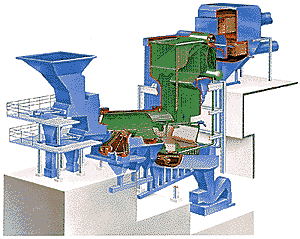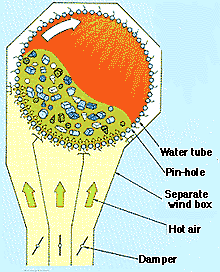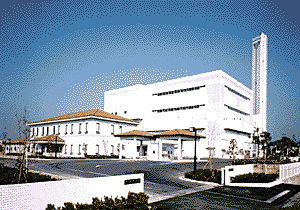Waste Treatment Technology in JAPAN
Drying, Incineration and Melting
IHI water-cooled rotary combustor, an incinerator for the municipal waste and solid industrial waste, was developed by IHI as the result of intensive research and development combined with IHl's broad technical knowledge and extensive experience as a boiler of integrated plants.
Fig 1 Construction of Rotary Combustor
Fig.2 Construction of Rotary Combustor (Cross sectional view)
Photo.1 Clean Center Kinuura
1. Construction and mechanism
1) Construction
The rotary combustor takes the form of a hollow cylinder which is slightly inclined downward from the horizontal plane. The rotary combustor wall consists of steel tubes and steel bands with a number of small pin-holes, no refractories are used.
2) Incineration system
The mass of wastes dumped into the rotary combustor from one end is continuously overturned and stirred by the rotation of the combustor while the optimum amount of air needed for combution is supplied, through the pin-holes in the combustor wall. The air is supplied evenly throughout the combustor in order to facilitate the drying and incineration of the wastes which will eventually be discharged, in the form of the ash, from the other end of the combustor.
3) Recovery of energy and protection of rotary combustor wall
The combustor wall is protected from the effects of high temperature by means of the boiler water circulated by forced circulation method in the-tubes which constitute the combustor wall. This circulating boiler water also absorbs the heat in the rotary combustor so that the energy can be recovered in the form of the steam.

2. Features
1) Capability of incinerating all kinds of wastes
With this rotary combustor, a wide range of solid wastes such as the following can be incinerated;
2) Excellent incinerating performance
(a) General wastes
Municipal waste, residual substances of sewage and human waste
(b) Industrial wastes
Wood refuse, bark, bagasse, palm waste, agricultural wastes, wastes of
paper, fiber, plastics, rubber, tires, residual substance of sewage etc.
With the rotation of the rotary combustor, the wastes in the combustor are stirred, mixed, dried, and burnt continuously and completely while the necessary amount air is supplied wherever required. Almost perfect incineration can be achieved and the unburned combustible in the ash is very little, around 3% at most.
3) Efficient energy recovery
This means the ash is hygienic.
Because the incinerator itself is constructed with water tubes and is united with the heat recovery boiler, the energy, in the form of steam, can be recovered efficiently. If this energy is utilized as power in the plant, the power cost for the operation can be reduced greatly.
4) Easy and trouble-free operation
Simplified moving parts and simple, strongly-built steel constructions assure the operators of easy and almost completely trouble-free operation. Furthermore, the incinerator can be operated with the minimum number of operators owing to simple and automated operation.
5) Easy maintenance and low maintenance cost
The rotary combustor including the heat recovery boiler has a solid and simple construction consisting of steel water tubes, requiring no fire bricks, and can be used almost permanently with only easy repair work and minimum maintenance cost.

3. Examples of incineration plant
1) Daikan Co.,Ltd ( Osaka pref. Japan )
(1) Treated waste: Industrial waste
(2) Capacity : 192 ton/day ( 96t/dX2 )
(3) Low heat value of waste : 4,600 kcal/kg
(4) Power generation capacity: 1,400 kW
2) Clean Center Kinuura ( Aichi pref. Japan )
(1) Treated waste: Municipal waste
(2) Capacity : 190 ton/day ( 95t/dx2 )
(3) Low heat value of waste : 2,800 kcal/kg
(4) Residue treatment: melting furnace
30 ton/day ( 15t/dx2 )
